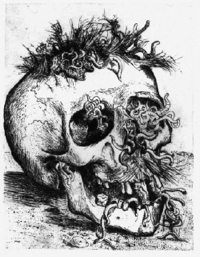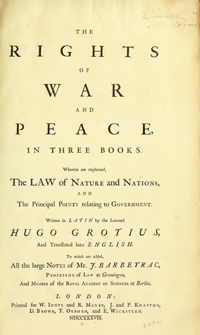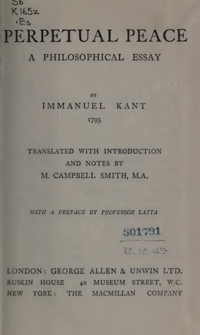


|
- Jean de Bloch's magnum opus Будущая война и её экономические последствия (Future War and its Economic Consequences) (1898) is a late 19th century counterpart to Carl von Clausewitz much more famous Vom Kriege (1832). While the generals went off to war in 1914 with their heads full of Clausewitzian ideas about the "Hauptschlacht" (the decisive battle) which would defeat the enemy quickly, economists like Bloch and Molinari predicted massive economic destruction, loss of life, and an end to the liberal order. The pairing of Clausewitz and Bloch, although not contemporaries, is another example of the "contested western tradition." [See Molinari's Grandeur et decadence de la guerre (1898) as well.].
- I have added a French edition of Jean de Bloch's prophetic and thus largely ignored 6 volume work on La Guerre (War) (1899) to the German language edition which I put online in 2014 as part of my commemoration of the start of WW1. Jean de Bloch (1836-1902) was a Polish born banker and railway
financier who lived and worked in Russia. The quick Prussian defeat of
France in 1870 led him to pursue a scientific study of what a modern
war might look like in the near future. This 6 volume work is remarkably
prescient in many of his predictions of what actually transpired in WW1
The graphs and statistical tables about the destructiveness of modern weaponry, the economic impact of modern warfare, and his
predicted death rates are especially interesting and frightening. A summary of his views also in French appeared in 1899 and again in 1900 [PDF] and a 1 vol. abridgement was published in English, The Future of War (1903) [PDF], extracts of which can be found here [HTML]. Unfortunately, the PDFs I got from the Gallica website are in "colour" and thus very large. It is interesting to note that the 6 volume French edition was published by Guillaumin which was the leading publisher of French classical liberal and economic works in the second half of the 19th century.
- the "conflicted" western tradition: I have added to my list of 26 texts in this collection Kant's Zum ewigen Frieden (On Perpetual Peace) (1795) to be paired with some of Hegel's writings such as Elements of the Philosophy of Right (1821). Whereas Kant saw war as a major threat to the limited constitutional republican state with its duty to protect the life, liberty, and property of its citizens, Hegel saw war as an essential means by which the state could reach its ultimate purpose and ideal form
- an early Christian advocate of peace was the Dutch theologian Desiderius Erasmus (c.1466-1536) who wrote several pieces in the early 1500s which have been translated and republished several times during later wars, such as the 30 Years War (1618-48), the Napoleonic Wars (1790s), and WW1. I first began putting his work online just after the invasion of Afghanistan and Irag in the early 2000s. These works inlcude (the link is to the English version, which is turn has links to other editions):
- "Enchiridion militis Christiani" (The Handbook of the Christian Soldier) (1501) - HTML and facs. PDF
- "Dulce bellum inexpertis" (War is sweet to those who have not experienced it) (1515) - HTML and facs. PDF
- "Querelus pacis" (The Complaint of Peace) (1518) - HTML and facs. PDF
- one of the great calls for peace written in the middle of war was Immanuel Kant's Zum ewigen Frieden (On Perpetual Peace) (1795). He was inspired by the idea of extending a treaty like the Treaty of Basel (1795) into a network of interlocking peace treaties between belligerent powers which would reduce the risks of war. He also thought the gradual spread of republican political ideas would lessen the chances of kings and emperors engaging in wars for their personal benefit and glorification. I have put online the German original in HTML and facs PDF; as well as an English translation published in the middle of yet another war (1917) in HTML and facs. PDF
- In my "illustrated essay" on “Jacques Callot and Hugo Grotius on Crime and Punishment in a time of War” I explore the problem of war in 17th century Europe by juxtaposing an image from the series of 18 etchings made by Jacques Callot (1592-1635) called "The Miseries of War" (1633) which graphically show the ravages of war in his native Lorraine during the Thirty Years War (1618-48), with passages from Hugo Grotius, The Rights of War and Peace (1625) which is a foundation stone of the modern understanding of the laws of war.
- another edition of Hugo Grotius's magisterial The Laws of War and Peace (1625), this time the authoritative 18th century edition produced by Jean Barbeyrac, Professor of Law at Groningen, with copious notes. This edition was translated into English in 1738: Hugo Grotius, The Rights of War and Peace, in Three Books. Wherein are explained, the Law of Nature and Nations, and the Principal Points relating to Government - HTML and facs. PDF
- To commemorate the 100th anniversary of the start of WW1 which, among
other things, destroyed the liberal poltiical and economic order which
had been built up in the second half of the 19th century, we have put
online some volumes of the Journal des économistes from this
period. One should note the multi-part series on the origins of the war
written by the editor Yves Guyot between August 1914 and April 1915 [PDF
16MB]. This was expanded and published as a book which is also
available in French [PDF
23MB] and English [PDF
8MB].
- Journal dés économistes. Revue mensuelle de la science économique
et de la statistique. Fondateur: Gilbert Guillaumin. Rédacteur
en chef: Yves Guyot. (Paris: Librairie Félix Alcan. Maisons Félix Alcan
et Guillaumin réunis, 108, Boulevard Saint-Germain):
- 6e série. Tome XLIII. Juillet à sept. 1914 [PDF
30MB] [ToC]
- 6e série. Tome XLIV. Oct. à déc. 1914 [PDF
23MB] [ToC]
- 6e
série. Tome XLV, Janvier à mars 1915 [PDF
27MB] [ToC]
- 6e
série. Tome XLVI. Avril à juin 1915 [PDF
41MB] [ToC]
- A collection of books on war by Bloch, Hirst, Guyot, Wilfred Owen, Hasek, Friedrich, et al.
- "War and Art" and "War Films"
- A speech on ANZAC Day 25 April 2014, “How we Remember War” [PDF].
- Lecture on "War
and Peace in the Art of Pablo Picasso: "Guernica"
(1937)"
- Some clips from war films
[See the archive.] |



